English
Our Intent
Reading
At Burston & Tivetshall Primary Schools, we believe that all our children can become fluent readers and writers. Therefore, we teach reading through Little Wandle Letters and Sounds Revised, which is a systematic and synthetic phonics programme. This is complemented by Little Wandle Fluency programme and extensive library to deliver high quality reading practice sessions that build the decoding knowledge needed to decipher words. We start teaching phonics in Reception and follow the Little Wandle Letters and Sounds Revised progression, which ensures children build on their growing knowledge of the alphabetic code, mastering phonics to read and spell as they move through school.
As a result, all our children can tackle any unfamiliar words as they read. At our schools, we also model the application of the alphabetic code through phonics in shared reading and writing, both inside and outside of the phonics lesson and across the curriculum. We have a strong focus on language development for our children because we know that speaking and listening are crucial skills for reading and writing in all subjects.
At our schools, we value reading as a crucial life skill. By the time children leave us, they read confidently for meaning and regularly enjoy reading for pleasure. Our readers are equipped with the tools to tackle unfamiliar vocabulary. We encourage our children to see themselves as readers for both pleasure and purpose.
Writing
At our schools we aim to inspire a joy and love of writing. Our teachers use The Write Stuff as their starting point for all units of work. This is based on two guiding principles; teaching sequences that slide between experience days and sentence stacking lessons. Modelling is at the heart of all teaching. Sentence stacking lessons are broken into bite-sized chunks. Teachers prepare children for writing by modelling the ideas, grammar or techniques of writing.
We want to inspire our young writers through the use of high quality texts which aim to build children's skill in writing across different genres. Our children develop resourcefulness and access texts in a wide variety of ways including drama, music and art.
By the age of 11, we aim to ensure that all children at Burston & Tivetshall Primary Schools:
- read easily, fluently and with good understanding.
- develop the habit of reading widely and often, for both pleasure and information.
- acquire a wide vocabulary, an understanding of grammar and knowledge of linguistic conventions for reading, writing and spoken language.
- appreciate our rich and varied literary heritage.
- write clearly, accurately and coherently, adapting their language and style in and for a range of contexts, purposes and audiences
- use discussion in order to learn; they should be able to elaborate and explain clearly their understanding and ideas and reflect on the effectiveness of the choices they have made.
- are competent in the arts of speaking and listening, making formal presentations, demonstrating to others and participating in debate.
Implementation
Phonics & Reading Comprehension
Daily phonics lessons in Reception and KS1
- We teach phonics for 30 minutes a day. In Reception, we build from 10-minute lessons, with additional daily oral blending games, to the full-length lesson as quickly as possible. Each Friday, we review the week’s teaching to help children become fluent readers.
- Children make a strong start in Reception: teaching begins in Week 2 of the Autumn term.
- We follow the Little Wandle Letters and Sounds Revised expectations of progress:
- Children in Reception are taught to read and spell words using Phase 2 and 3 GPCs, and words with adjacent consonants (Phase 4) with fluency and accuracy.
- Children in Year 1 review Phase 3 and 4 and are taught to read and spell words using Phase 5 GPCs with fluency and accuracy.
Daily Keep-up intervention lessons ensure every child learns to read
- Any child who needs additional practice has daily Keep-up intervention sessions, taught by a fully trained adult. Keep-up sessions match the structure of class teaching, and use the same procedures, resources and mantras, but in smaller steps with more repetition, so that every child secures their learning.
- We timetable daily phonics lessons for any child in Year 2 who is not fully fluent at reading or has not passed the Phonics Screening Check. These children urgently need to catch up, so the gap between themselves and their peers does not widen. We use the Little Wandle Letters and Sounds Revised assessments to identify the gaps in their phonic knowledge and teach to these using the Keep-up resources – at pace.
- If any child in Year 3 to 6 has gaps in their phonic knowledge when reading or writing, we plan phonics/reading ‘catch-up’ lessons to address specific reading/writing gaps. These short, sharp lessons last 10 minutes and take place at least two times a week.
Teaching reading: Reading practice sessions two times week
- Children in Reception and Year 1 as well as any child still following the Little Wandle scheme of learning, are also taught to read through reading practice sessions that take place a minimum of two times a week. These:
- are taught by a fully trained adult to small groups of a maximum of six children
- use books matched to the children’s secure phonic knowledge using the Little Wandle Letters and Sounds Revised assessments and book matching grids on pages 11–20 of ‘Application of phonics to reading’
- are monitored by the class teacher, who rotates and works with each group on a regular basis.
- Each reading practice session has a clear focus, so that the demands of the session do not overload the children’s working memory. The reading practice sessions have been designed to focus on three key reading skills:
- decoding
- prosody: teaching children to read with understanding and expression
- comprehension: teaching children to understand the text.
- In Reception these sessions start in Week 4. Children who are not yet decoding have daily additional blending practice in small groups, so that they quickly learn to blend and can begin to read books.
- In Year 2 and 3, we continue to teach reading in this way for any children who still need to practise reading with decodable books.
Home reading
- The decodable reading practice book is taken home to ensure success is shared with the family.
- Reading for pleasure books also go home for parents to share and read to children.
- We use the Little Wandle Letters and Sounds Revised parents’ resources to engage our families and share information about phonics, the benefits of sharing books, how children learn to blend and other aspects of our provision, both online and through workshops.
Additional reading support for vulnerable children
- Any children who are receiving additional phonics Keep-up sessions receive additional 1-1 reading sessions during the week.
Ensuring consistency and pace of progress
- Every teacher in our school has been trained to teach reading, so we have the same expectations of progress. We all use the same language, routines and resources to teach children to read so that we lower children’s cognitive load.
- Weekly content grids map each element of new learning to each day, week and term for the duration of the programme.
- Lesson templates, Prompt cards and 'How to videos' ensure teachers all have a consistent approach and structure for each lesson.
- The Reading Leader and SLT regularly monitor and observe teaching; they use the summative data to identify children who need additional support and gaps in learning.
Whole Class Guided Reading
During a typical whole class guided reading session the teacher will share what the content domain/s the children will be focusing on for that session.
KS1
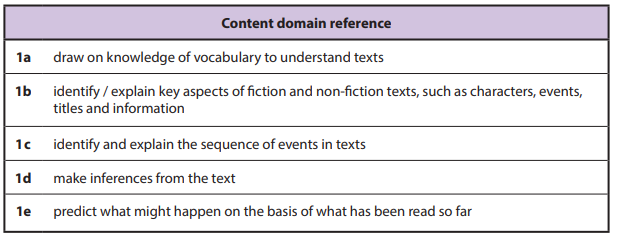
KS2
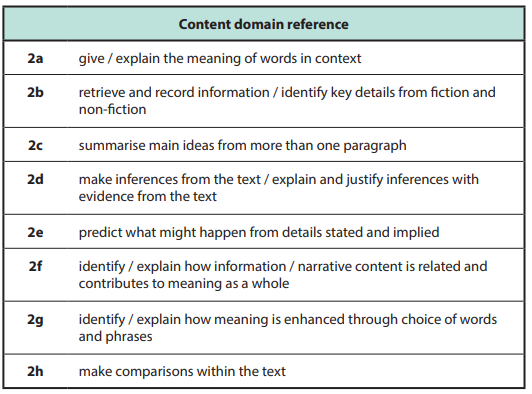
During the course of the year teachers cover both fiction and, non-fiction, poetry, picture books, short films to ensure children get access to a wide range of texts. Types of text given are appropriate to the age and key stage of the children.
Children read during these sessions in a variety of different ways. They may hear the teacher model fluent reading and then have time to reread the same extract themselves, they may read individually and feedback, work in groups, take turns in pairs or read aloud to their peers. You may see a number of these different strategies during one session or across the week.
Teachers will model how to answer different types of questions as well as encouraging children to orally speak the answer before writing anything down acknowledging their first answer may not always be their best. At times children are given sentence stems and vocabulary that is expected to be used within their answer.
We also acknowledge it is good for children to also be able to formally record an answer. Children can do this in a variety of different ways such as discussing the answer first with peers and/or an adult and then writing their best answer, working individually and then editing their answer accordingly after discussion or orally discussing 1 or 2 of the questions and writing down the others working individually.
Hearing children read during whole class guided reading.
During this reading session teachers focus on specific children during the session, this may mean hearing them read individually whilst others are reading independently, in pairs or groups, discussing answers with those children and working one to one or within a group with them during a session whilst the others form an answer independently. Teachers can then assess these children based on NC expectations and how they are performing relating to the specific content domain.
Ensuring reading for pleasure
We value reading for pleasure highly and work hard as a school to grow our Reading for Pleasure pedagogy.
- We read to children every day. We choose these books carefully as we want children to experience a wide range of books, including books that reflect the children at our school and our local community as well as books that open windows into other worlds and cultures.
- Every classroom has an inviting book area / class bookshelf that encourages a love for reading. We curate these books and talk about them to entice children to read a wide range of books.
- In Reception, children have access to the reading area every day in their free flow time and the books are continually refreshed.
- Children from Reception onwards have a home reading record. Parents/carers can record comments each time they listen to their child read, to share with the adults in school. Adults are encouraged to write in this on a regular basis to ensure communication between home and school.
- The school library is made available for all classes to use. Children across the school have regular opportunities to engage with a wide range of Reading for Pleasure events (book fairs, author visits and workshops, national events etc).
Speaking, Listening and Drama
We help children to develop confidence and articulacy in their speaking, listening and drama by:
- Ensuring that children should have opportunities to take part in purposeful and relevant discussions, including formal debates with cross-curricular themes
- Supporting children in the learning of age-appropriate poetry by heart for pleasure and performance.
- Providing opportunities for children to develop skills in public speaking such as showcases and class assemblies.
- Ensuring that children can rehearse, perform, and critically respond to dramatic works that they have created.
Writing
Our approach to writing is supported by Jane Considine’s methods, taken from her book, “The Write Stuff”. There are 3 zones of writing that we encourage the children to write through.
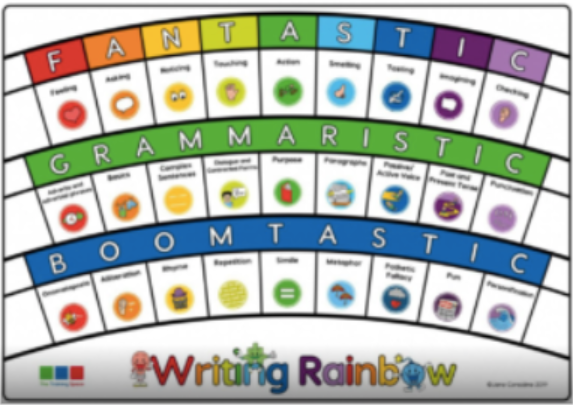
We believe that writing is only strengthened when children have good imaginations, which we can remember using the FANTASTIC acronym…
Next come the techniques, which are part of the BOOMTASTICs system. They enable children to showcase their personal voice and writerly style through the techniques they use…
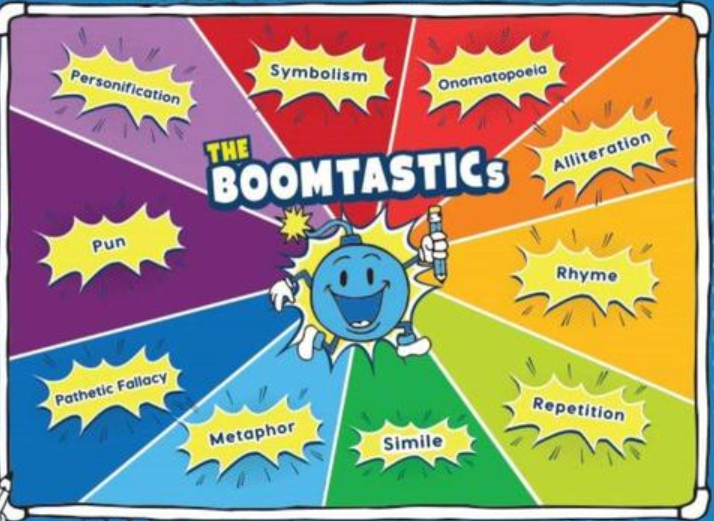
And, lastly, there are the tools. Children need to be in control of their grammar choices to improve the precision and the impact of their writing.
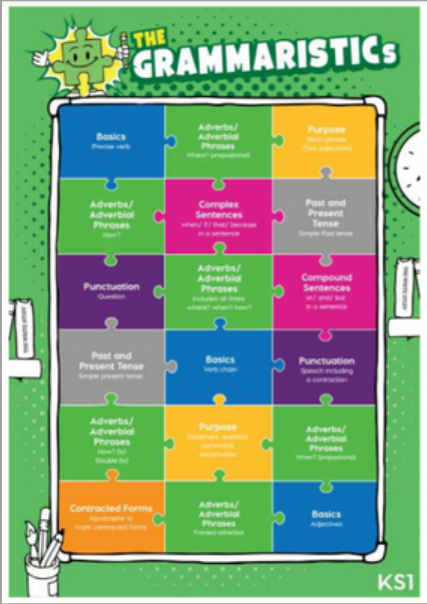
Key aspects of The Write Stuff system include:
- The Write Stuff builds pupils’ confidence with sentence structure.
- The approach widens the repertoire of writing options for pupils.
- Pupils gain an understanding of the ‘whole’ piece that they are writing.
- Organisation of their ideas and cohesion between them is strengthened.
English
To ensure that all children reach their potential in writing we will:
- Ensure that writing has a clear purpose and audience and where possible has cross-curricular links.
- Encourage the love of writing for its own sake.
- Provide children with first-hand experiences to inspire imaginative writing.
- Provide children with guidance and support to improve; to give children an understanding of their writing ‘level’ and support them in developing realistic, personal targets.
- Immerse children in a vocabulary-rich culture where children are not afraid to experiment with new and exciting language.
- Provide children (identified through assessment) with a range of appropriate interventions to support them in overcoming barriers to progress.
Spelling, Grammar and Handwriting
At Burston and Tivetshall, we firmly believe that spelling is an essential skill that allows the children to communicate affectively their understanding in all curriculum subjects. In order that pupils develop into confident writers, they need to develop and use a range of secure spelling strategies. By providing children with a range of strategies, we equip them with the independence to attempt spellings before asking for adult help. We particularly want our children to develop a love of language and the confidence to spell more challenging and ambitious words. By giving them the opportunity to develop a rich and exciting vocabulary, we are enabling them to become effective communicators.
To ensure that all children reach their potential in spelling and grammar we will:
- Provide regular spelling sessions linked to the age-specific spelling programme set out in the National Curriculum 2014 as well as a focus on 'high frequency word' lists. Teachers are supported by the 'The Little Wandle spelling program and Spelling Shed' programmes which they adapt for thier weekly spelling lessons.
- Ensure that our learning environment is rich with language;
- Use formative and summative assessment of children’s spelling termly in Years 1-6 and use this to adjust interventions.
- Use a clear lesson structure of revision and review, direct input and new learning and consolidation and application.
- Systematic and formal teaching of handwriting will be carried out using the Letterjoin programme.
- Staff will model appropriate handwriting styles.
Impact
Phonics
Assessment: Assessment is used to monitor progress and to identify any child needing additional support as soon as they need it.
- Assessment for learning is used:
- daily within class to identify children needing 'Keep-up support'
- weekly in the 'Review lesson' to assess gaps, address these immediately and secure fluency of GPCs, words and spellings.
- Summative assessment is used:
- half termly to assess progress, to identify gaps in learning that need to be addressed, to identify any children needing additional support and to plan the Keep-up support that they need.
- by SLT and scrutinised through the Little Wandle Letters and Sounds Revised assessment tracker, to narrow attainment gaps between different groups of children and so that any additional support for teachers can be put into place.
Statutory assessment
- Children in Year 1 sit the Phonics Screening Check. Any child not passing the check re-sits it in Year 2.
Ongoing assessment for catch-up
- Children in Year 2 to 6 are assessed through their teacher’s ongoing formative assessment as well as through the half-termly Little Wandle Letters and Sounds Revised summative assessments.
Reading
- Children will be assessed in line with age related expectations set out in the assessment documents of the 2014 National Curriculum.
- Regular structured assessments will be undertaken to monitor progress throughout the school year and to enable the setting of relevant, realistic personal targets.
Writing
Assessment
- Assessment will be undertaken in line with the school’s marking and feedback policy.
- Children will be assessed in line with age related expectations set out in the assessment documents of the 2014 National Curriculum.
- Regular structured assessments will be undertaken to monitor progress throughout the school year and to enable the setting of relevant, realistic personal targets.
Moderation: Staff take part in Trust wide termly moderation to ensure that teacher judgements are scrutinised and accurate.


